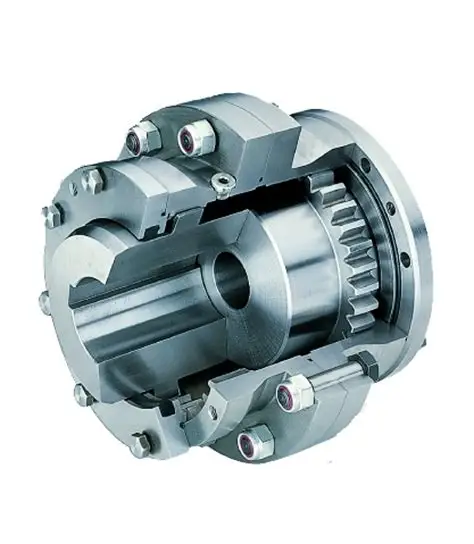GEAR COUPLING
Gear couplings are torsionally rigid and are equipped to  two types â totally flexible and flexible/rigid. A fully versatile coupling comprises two hubs with an exterior equipment and two outer sleeves with an internal gear. It is a universal coupling for all sorts of programs and accommodates all achievable misalignments (angular, offset and combined) as well as massive axial times. Devices, bearings, seals, and shafts are as a result not subjected to the added forces, occasionally of appreciable magnitude, which come up from unavoidable misalignment normally associated with rigid shaft couplings.
two types â totally flexible and flexible/rigid. A fully versatile coupling comprises two hubs with an exterior equipment and two outer sleeves with an internal gear. It is a universal coupling for all sorts of programs and accommodates all achievable misalignments (angular, offset and combined) as well as massive axial times. Devices, bearings, seals, and shafts are as a result not subjected to the added forces, occasionally of appreciable magnitude, which come up from unavoidable misalignment normally associated with rigid shaft couplings.
A versatile/rigid coupling comprises one flexible geared fifty percent and 1 rigid 50 %. It does not accommodate parallel displacement of shafts but does accommodate angular misalignment. This kind of couplings are mostly utilised for “floating shaft” apps.
Dimensions 010 â 070 all have crowned teeth with a 20° strain make contact with (fig one). This enables to accommodate up to one,5° static angular misalignment for each equipment mesh. Nevertheless, reducing the operational misalignment will improve the life of the coupling as properly as the existence of other machinery elements this kind of as bearings and so on.
Gear COUPLING
equipment coupling is a torsionally rigid grease crammed coupling consisting of two hubs with exterior multicrown – and two flanged sleeves with straight inner enamel. The flanged sleeves are bolted collectively with substantial power corrosion safeguarded equipped bolts and nuts. The sleeve is at the opposite facet of the flange executed with an endcap (inside for little and screwed for large dimension couplings) in which the o-ring is situated for sealing purposes. The gear coupling has been designed to transmit the torque amongst these two flanges via friction avoiding fretting corrosion in between these faces.
The enamel of hub and sleeve are constantly in make contact with with every single other and have been designed with the needed backlash to accommodate angular-, parallel- and axial misalignment inside of their misalignment capability. The angular and parallel misalignment capability is established by the gear tooth design and is for the standard gear max. one.5° degrees (2 x .75°) in complete. The axial misalignment capability is restricted by the gear enamel size in the sleeve and can be assorted (optionally).
Would certainly you prefer to enhance your knowledge regarding CHINA GEAR COUPLING?